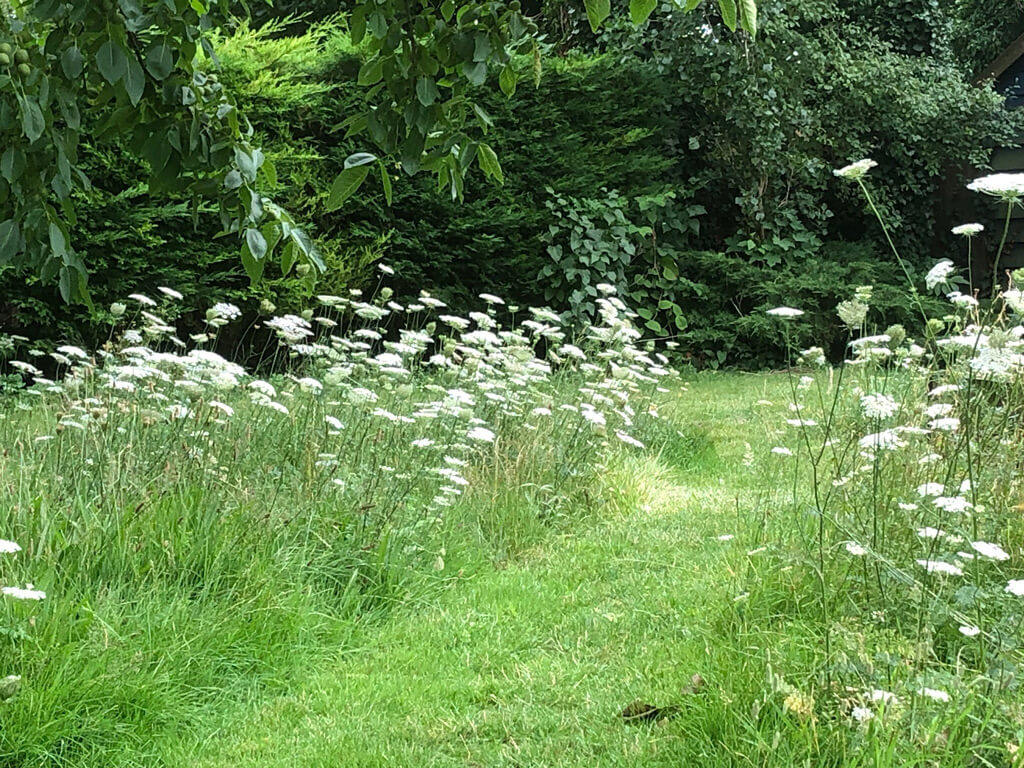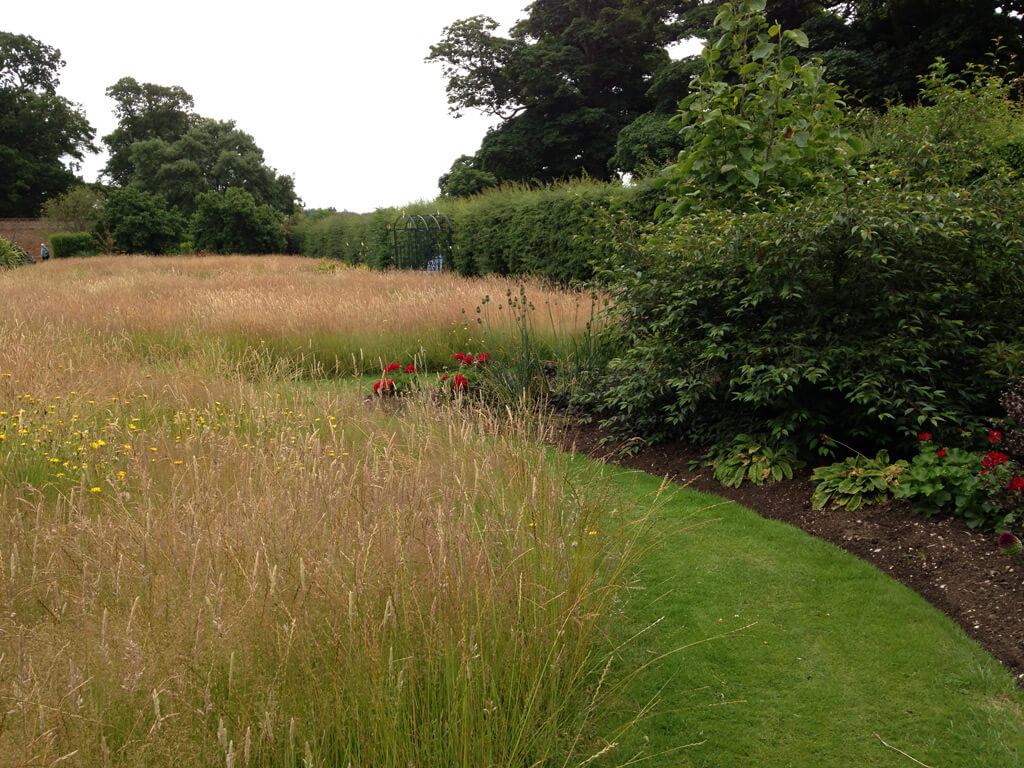A wildflower lawn may not need weekly mowing but it does need maintenance. As summer wildflowers fade and the grasses start to flop, we’re sharing out thoughts on when to cut a wildflower lawn.
More and more people are letting the grass grow under their feet to help wildlife to thrive in our gardens. As a trained greenkeeper I’m all for it. We used to call wildflower areas the “rough”. I always thought that the contrast between these areas and the mown grasses was easy on the eye and I enjoyed watching the wildlife within them.
That said, if wildflower areas are not to become an eyesore, they do need careful and timely management. Namely cutting, re-greening and re-seeding. Let’s take a look

A wildflower lawn in spring. The mown path invites visitors to take a closer look whilst ensuring that the garden doesn’t look like a pasture.
How to grow a wildflower lawn
There are several different ways to grow a wildflower lawn. Some people like to remove a layer of turf and sow wildflower seed into the soil that has been revealed. Others are happy to stop mowing and let Mother Nature do as she pleases. It all depends on the effect you want to achieve.
You may want to go for the “hay meadow” effect. In which case allow an area to grow freely between early spring and midsummer then cut it back once the plants have set seed. This looks great with just grasses and works really well in areas that have been underplanted with spring flowering bulbs. If you avoid letting broadleaved plants establish in the sward, you’ll find it easy to return it to a manicured lawn for the autumn and winter year.
Alternatively, you might choose to allow low growing wildflowers to bloom in your lawn but perhaps mow every fortnight to avoid the jungle look. In my experience, this is a great way to keep your lawn lush and green all summer long.
Either way, you will need to control pernicious weeds such as docks and dandelions and just allow the plants that you like the look of.
Featured Video
Title of your featured video
Featured video sub text description
Featured Video
How to maintain the perfect city lawn
Aeration of lawn to keep it in tip-top condition.
How to prevent your wildflower lawn looking a mess
There’s a fine line between re-wilding and neglect. As I’ve already mentioned, some wild plants can make a wildflower area look awful. I’m thinking about those plants with huge leaves and bad habits. Docks and thistles are my least favourite wildflowers but I’m not averse to birdsfoot trefoil, oxeye daisies, yarrow and the like. In fact they look fabulous nodding about among the grasses and they won’t grumble about being mown.

This lawn shares it’s garden with a thriving hive full of honey bees who enjoy the succession of wildflowers. When summer is over, the lawn will be mown short again
One tip I found useful when maintain the areas of rough on the golf course, was to keep the lawns around the meadow areas really well manicured. That neat, sharp edge shows that the area is cared for. In a garden, you may want to mow some nice wide paths into the longer grasses – or maybe even use your mower to carve out and maintain a seating area.
When to cut your wildflower lawn
For a biodiverse lawn, otherwise called a species rich lawn. You’ll want to keep cutting it all year round. But lift your mower blades and only trim once a fortnight or so. That will give flowering plants plenty of opportunity to nourish the bees and other insects that come to visit. Think of the mowing as a form of deadheading. When you lop the unformed seedheads off clover, buttercups, selfheal and daisies, the plants will produce another flush of flowers. Always collect the clippings.
For a hay meadow type wildflower lawn, cutting needs to happen once any flowers have faded but before everything falls over. That can be anytime between late June and late August. It all depends on what species are in your wildflower lawn and what sort of weather we’re having. As a rule of thumb, once the grasses have set seed and turned from green to gold, it’s time to cut them. The more strawlike they become, the more likely they are to fall over.

Keeping lawn edges neat and manicured ensures that your wildflower lawn doesn’t look too informal (this is actually the walled garden of a country house).
The grass here is just changing colour – I would plan to mow this in 2-3 weeks time.
When you do cut back long grasses think carefully about your technique. The idea is to remove all spent vegetation but still allow the plants to regenerate. Especially if you want wildflowers in the same area next year.
The tools for wildflower lawn care
It may be tempting to get the strimmer out, but that would be a mistake. A nylon cord strimmer is brutal in the way it treats plants. Instead of leaving a nice clean wound that will heal immediately, a strimmer beats and bashes at the stems spreading debris left right and centre. No, if you are going to mow your wildflower meadow yourself, please use a brushcutter or a good old fashioned scythe. I find my long handled hedge trimmer is ideal for the job.
Whatever you do, don’t go scalping the area. Just reduce the height of the vegetation down to about 10 – 15cm (4 – 6 inches). Leave the clippings to dry for a day or two so that the seeds drop back into the sward, and then rake them all up and remove them. If you don’t want wildflowers here next year, it’s OK to take the clippings away immediately.
Restoring your lawn after wildflowers have been cut
The reason I always advise people to mow their lawns little and often is that when a large proportion of a grass blade is removed, the plant is stressed and you’ll see a noticeable change in the colour of the lawn. Mowing frequently also supresses the plant’s desire to set seed. For once grass has set seed, the foliage will change colour and texture.
So in a wildflower meadow, when the grass has set seed, you’ll find that removing the vegetation leaves you with coarse, bristly, pale brown stumps. A bit like a farmer’s field after the combine harvester has done its work. That’s not the prettiest thing to look at, so you’ll want to be encouraging some green shoots as soon as possible.
Your best friend is going to be water. If Mother Nature doesn’t offer up any rain, water the area really well using the same principals as I describe in my lawn watering video. None of this light sprinkling to settle the dust. The soil needs to be really soaked so that the water goes deep into the soil. Do that at least once a week until you see strong growth.
Returning a wildflower lawn to a cultivated lawn
Cultivated lawns need a very different regime to wildflower lawns. In fact the two are polar opposites. For a cultivated lawn we feed the grass so that it will outcompete the wildflowers (aka weeds). Wildflowers prefer a nutrient poor soil. So, for a wildflower meadow we starve the grass to allow the flowers to take over.
If you are not planning on cultivating wildflowers for next year, now is the time to apply a nice feed supplemented with an organic seaweed treatment to boost recovery and growth. You can start mowing the area once the fresh young grass is around 7.5cm (3 inches tall). Just take the tips off the grass blades for the first couple of cuts. Then gradually reduce the cutting height to where you’d like it to be.
Regular mowing will weaken some of the wildflowers but not all of them. As soon as the grass is strong enough you will need to treat the weeds in your lawn. If you’re not sure what you are dealing with, talk to a lawn care professional who understands how to use chemical treatments judiciously.
As soon as the weather starts to cool, I’d recommend scarifying and aerating your lawn and then applying an autumn feed to give those roots everything they need to prepare for the year ahead.
Improving your wildflower lawn for next year
If you are planning on cultivating an even better wildflower meadow for next summer. Your job now is to try to reduce soil fertility. It’s OK to water the plants to encourage them to green up but don’t add any fertiliser.
Traditionally, the farmer would release his cows or sheep onto the meadow after hay cutting. You perhaps don’t have any livestock in your garden but you can simulate grazing by mowing regularly and removing the cuttings. Beware of mowing too low though. Grass grows from the base of the leaves and will bounce back after a scalping. Broadleaved plants grow from the tops of their stems. If you cut back too far the plant won’t be able to recover.
If you want to add more wildflowers, you can add plug plants now. Another tip is to cut very grassy areas as short as you dare. Be brutal as you rake out as much of the grass as you can and then sow some Yellow Rattle seeds. Yellow Rattle weakens grass plants as it grows and will help stop it choking the wildflowers.
Need some help restoring your lawn after wildflowers?
If you have been experimenting with wildflowers in your lawn but now want to restore it to its former glory, Premier Lawns are here to help.
We have specialist treatments to remove weeds and optimise grass growth giving you a lush, verdant lawn that will make the neighbours jealous.
You might also like these articles
Your lawncare calendar – a month by month guide to creating and maintaining your perfect lawn. Read it here
Caring for a newly renovated lawn – Robbie Lynn, Belfast’s lawn care expert explains how to look after a lawn that is recovering from rejuvenating treatments. Read it here
How to get rid of weed grasses in your lawn – you may find that a temporary wildflower lawn allows coarse and ugly weed grasses to invade your grass lawn. This video explains how to remove them without using chemicals. Watch it here


